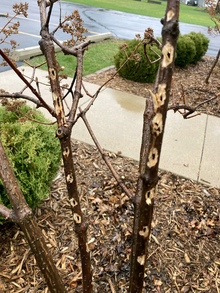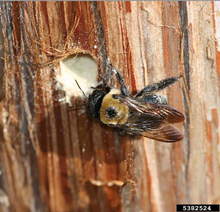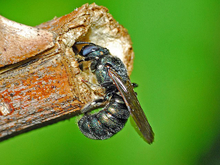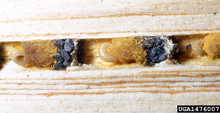In mid-May, a Blue Earth County Master Gardener brought me some curious twigs from a hydrangea. Riddled with holes, it looked like someone took an ice pick and hacked at the poor plant. Given how rough and splintered the holes were, birds were the number one suspect. But why did they attack?
After looking at the branches, it reminded me of the emerald ash borer. One of the first things a homeowner sees on an infested ash is bird damage—not really anything from the insect itself. Larvae in trees, including emerald ash borer larvae, are a choice food source for woodpeckers and nuthatches. Perhaps something tasty—to birds anyway—lived inside this hydrangea too?
To double-check my insect theory, I decided to split some of the branches to see if anything was present. The hungry birds did a lot of work to destroy any evidence—I could not find any grub or larva. While the critter likely met its end in a bird’s beak, I was able to clearly see that something was there—the hydrangea cane was completely hollowed out, and what looked like frass (insect poop) was present.
Then came the hard part, what exactly was this mystery insect? While many gardening blogs and videos mentioned a “hydrangea cane borer”, none of them listed a species or even a photo of the culprit. Some websites guessed it was a beetle or a clearwing moth, but offered little evidence. I also tried to see if any insect borers used hydrangea as an alternative host, but no dice.
The suspect is revealed
After submitting the sample to the UMN Plant Disease Clinic, finding a “hydrangea borer” photo on the Ask Extension website, and consulting with UMN bee experts, we got an ID! It was not a mythical “hydrangea cane borer” but likely a humble stem nesting bee. Specifically, we thought it was a small carpenter bee (Ceratina sp.)
Small carpenter bees have a metallic look about them, with sparsely hairy bodies and a stout head. The “carpenter” in their name is a bit misleading. Most Ceratina species make their homes in woody perennial stems, not people’s houses.
“Carpenter” might fit their distant cousins better, the large carpenter bees (Xylocopa spp.) Large carpenter bees look very different—similar to a bumble bee—and can occasionally damage decks and other untreated lumber. Xylocopa male bees are notoriously territorial, buzzing around your head if you step near their turf—pretty brave of them considering the males have no stinger to hurt you with.
In contrast to Xylocopa species, small carpenter bees are usually low-key. These insects prefer pithy stems to make their homes, and hydrangea bushes fit the bill. Ceratina bees do not snip off the tips of healthy branches and need some sort of weak point to start their stem nesting process. In the case of the hydrangea I saw, someone had deadheaded the flowers the year before, and that is what likely gave the bee an entrance to the canes. As the female bee hollows the branch, she then divides it into cells where she lays an egg and stores food in each.
Gardening with small carpenter bees
It is important to note that small carpenter bees are not considered serious pests of ornamental plants. While they can sometimes tunnel deeply in living canes, they are not known for killing entire bushes or causing widespread damage. In fact, most entomologists consider the small carpenter bee a beneficial pollinator rather than a pest. Ceratina species have even been observed visiting and pollinating important crops such as cucumber and apple.
What about control? Common methods gardeners use to deter stem nesting bees, such as sealing pruning cuts with glue or applying pesticides, are not recommended by most university extensions. However, as was true in the case of the hydrangea bush, peckish birds seem to be an all-natural solution.
If you want to support small carpenter bees, creating additional habitat is key. On the UMN Bee Lab’s Create Nesting Habitat page you can find a handout tailored to stem nesters. Ceratina bees' favorite plants, such as elderberries and raspberries, also double as great choices for hardy, edible landscapes in Minnesota.
Biddinger, D., Rajotte, E., & Joshi, N. K. (2013). Wild bees as alternative pollinators in Pennsylvania apple orchards. Proceedings, the Great Lakes Fruit, Vegetable and Farm Market EXPO and the Michigan Greenhouse Growers Expo, Michigan.
Koenig, W. D., Liebhold, A. M., Bonter, D. N., Hochachka, W. M., & Dickinson, J. L. (2013). Effects of the emerald ash borer invasion on four species of birds. Biological Invasions, 15(9), 2095-2103.
Smith, A. A., Bentley, M., & Reynolds, H. L. (2013). Wild bees visiting cucumber on Midwestern US organic farms benefit from near-farm semi-natural areas. Journal of economic entomology, 106(1), 97-106.






